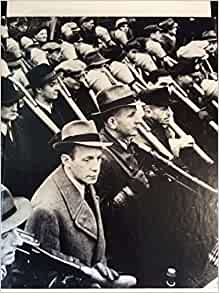(单词翻译:单击)
听力文本
Welcome to THE MAKING OF A NATION – American history in VOA Special English. I'm Steve Ember. The United States entered the Second World War in December of forty-one. Europe had already been at war since nineteen thirty-nine. But the United States did not enter World War Two until Japanese forces attacked the American naval base at Pearl Harbor, Hawaii. The attack was a surprise. But American military and political leaders had believed that the United States, sooner or later, would be pulled into the fighting. And they began to prepare for war. President Franklin Roosevelt had been assistant secretary of the Navy under President Woodrow Wilson during World War One. He remembered how American troops were not ready for that war. Now that he was president, Roosevelt wanted to be sure that the United States would be ready when it had to fight. Throughout nineteen forty-one, Roosevelt urged American industries to produce more weapons and other military supplies. He established new government agencies to work with industry to increase arms production.
Some business leaders resisted Roosevelt's efforts. They felt there was no need to produce more arms while the United States was still at peace. But many others cooperated. And by the time Japan attacked Pearl Harbor, the American economy was producing millions of guns and other weapons. Still, this was not enough to fight a war. After the Japanese attack, Roosevelt increased his demands on American industry. He called for sixty thousand warplanes, forty-five thousand tanks and twenty-thousand anti-aircraft guns. And he wanted all these within one year. A month after the Pearl Harbor raid, Roosevelt organized a special committee to direct military production. He created another group to help companies find men and women for defense work. And he established a new office where the nation's best scientists and engineers could work together to design new weapons. These new government organizations faced several problems. Sometimes factories produced too much of one product and not enough of another. Sometimes tools broke. And some business owners refused to accept government orders.

But the weapons were produced, and American troops soon had the guns and supplies they needed. The federal government had to quickly expand its own workforce to meet war needs. Federal spending increased from six billion dollars in nineteen forty to eighty-nine billion in nineteen forty-four. That was fifteen times as much spending in just five years. Roosevelt had to take strong steps to get the money for all this spending. He put limits on wages. He increased income taxes to as much as ninety-four percent on portions of incomes over two hundred thousand dollars. And he asked the American people to lend money to the federal government. The people answered by purchasing almost one hundred billion dollars in war bonds. The great increase in public spending raised the threat of high inflation. Roosevelt created a special office with the power to control prices. Many Americans agreed with the idea of price controls. But every business wanted somebody else's prices controlled, not their own.
Federal officials had to work hard to keep prices and supplies under control. They restricted how much meat, fuel and other goods people could buy. The price control program generally worked. Its success kept the American economy strong to support the troops fighting in Europe and Asia. One reason these strong economic steps worked was because most of the American people fully supported the war effort. You can look at photographs of people from those times and see in their faces how strongly they felt. In one picture from the state of North Carolina, a group of men are standing in front of old rubber tires. They are planning to give the tires to the Army to be fixed and used for military vehicles. Another photo shows a woman visiting a hospital. She is singing to a soldier to lift his spirits. Still another photo shows a man who owns a small food store. He is placing signs on meat and cans of food to tell people how much they are allowed to buy. You can also get an idea about the feelings of the times by the names of some of the popular songs during World War Two. In addition to "Rosie the Riveter," there were songs like "Praise the Lord and Pass the Ammunition." One of the most hopeful songs was this one, recorded by Britain's Vera Lynn.
重点解析
1.sooner or later 迟早;早晚
Sooner or later you will have to make a decision.
你早晚得拿个主意。
2.at peace 和平;处于和平状态
The countries have been at peace for more than a century.
这些国家和平共处已有一个多世纪。
3.refuse to 不肯;拒绝
I refuse to compromise my principles.
我拒绝在原则问题上妥协。
4.in addition to 除……之外;除了
In addition to my weekly wage, I got a lot of tips.
除了每周的薪水外,我还能得到不少小费。
参考译文
欢迎收听VOA慢速英语之建国史话节目,我是史蒂夫·恩伯。美国在1941年12月加入二战,而欧洲自1939年就一直处于战争状态。但直到日军袭击夏威夷珍珠港的美国海军基地,美国才参战。这是一次突袭,但是美方军事和政治领导人认为,美国迟早会被卷入战争。他们开始为战争做准备。富兰克林·罗斯福总统在第一次世界大战期间,曾在伍德罗·威尔逊总统领导下担任海军副部长。他记得美军没有为那场战争做好准备。罗斯福现任总统,他希望确保美国在必须战斗时做好准备。1941年一整年,罗斯福敦促美国工业生产更多的武器和其他军事物资。他建立了新的政府机构与工业界合作,以增加武器生产。
一些商界领袖抵制罗斯福的努力,他们认为,在美国仍处于和平状态时,没必要生产更多的武器。但其他许多人进行了合作。当日本攻击珍珠港时,美国正在生产数以百万计的枪支和其他武器。不过,这还不足以应战。日军进攻后,罗斯福增加了对美国工业的要求。他要求生产6万架战机、4.5万辆坦克和2万门高射炮,并希望在一年内建造完成。珍珠港突袭一个月后,罗斯福组织了一个特别委员会来指挥军事生产。他创建了另一个组织,帮助公司寻找从事国防工作的员工。他还组建一个新的办公室,让美国最好的科学家和工程师一起设计新型武器。这些新的政府组织面临着几个问题。有时,工厂生产的一种产品太多,而另一种产品却不够。有时工具坏了,还有一些企业主拒绝接受政府的命令。
但是武器生产出来了,美军很快就有了所需的枪支和物资。联邦政府不得不迅速扩充自己的人力以满足战争的需要。联邦开支从1940年的60亿美元增加到1944年的890亿美元,这是五年内开销的15倍。罗斯福不得不采取强有力的措施为所有开支筹集资金,他限制工资,把超过20万美元的部分所得税提高到94%,并要求美国人民把钱借给联邦政府,人们还要购买将近1000亿美元的战时公债。公共开支的大幅度增加加大了高通胀的威胁。罗斯福创建了一个有权控制物价的特别办公室。许多美国人同意控制物价的想法,但每家企业都希望别人的价格,而不是自己的价格受到控制。
联邦官员不得不努力控制物价和供应,他们限制人们可以购买的肉类、燃料和其他商品的数量。总体而言,价格控制计划是有效的。它的成功使美国经济保持强劲,以支持在欧洲和亚洲作战的军队。这些强有力的经济措施奏效的一个原因是,大多数美国人民全力支持战争。你可以看看当时人们的照片,从他们的脸上看的出他们的强烈感受。在北卡罗来纳州的一张照片中,一群人站在旧橡胶轮胎前。他们正计划把轮胎交给军队修理,然后用于军用车辆。另一张照片是一名女性正在医院就诊,她给一位士兵唱歌,使他振作起来。还有一张照片上是一位小食品店店主,他在肉和罐头食品上贴上标牌,告诉人们可以购买的数量。你还可以通过一些二战期间流行歌曲的名字,来了解当时人们的感受。除了《铆钉女工萝西》,还有像《感谢上帝给我送来弹药》这样的歌曲,其中最充满希望的是由英国人维拉·林恩录制的这首歌曲。
译文为可可英语翻译,未经授权请勿转载!


